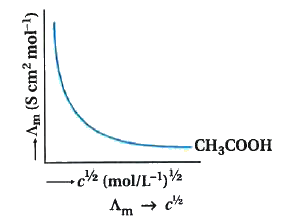What is weak electrolyte ? Explain relation between concentration of weak electrolyte and molar conductivity with suitable graph.
Text Solution
* (a) Weak electrolyte : Electrolytes which gives minimum ionization in its aqueous solution are known as weak electrolyte. They give ionic equilibrium in their aqueous solution. E.g., CH3COOH,NH4OH etc are examples of weak electrolyte.
* (b) Λm of weak electrolyte of solution and concentration : For such electrolytes, the change in Λm with dilution is due to increase in the degree of dissociation and consequently the number of ions in total volume of solution that contains 1 mol of electrolyte.
"According to Ostwald.s law of dilution, the conductivity of weak electrolyte solution is significantly increasing with decrease in concentration of solution with weak electrolyte. (e.g., CH3COOH)".
* (c) Explanation of conductivity on dilution :
Dissociation constant of weak electrolyte like acetic acid is low at higher concentration. So change in conductivity of solution of weak electrolyte, increases withthe increase in degree of dissociation. hence, total value of solution with solution of 1 mol of weak electrolyte increases with dilution and molar conductivity significantly increases with the increase in number of ions.

* Limiting molar conductivity of weak electrolyte and measurement of A:
* The graph is not linear, but it is curve. in this graph accurate slope is not observed and so we couldn.t get accurate value for slope and A.
* This graph doesn.t possess intercept, so we cant.s obtain the value of Λ∘m, because there is no intercept even at zero concentration of Λm value.
|
Topper's Solved these Questions
- ELECTROCHEMISTRYBOOK - KUMAR PRAKASHANCHAPTER - ELECTROCHEMISTRYEXERCISE - SECTION-A (Try Yourself)
25 Videos
- ELECTROCHEMISTRYBOOK - KUMAR PRAKASHANCHAPTER - ELECTROCHEMISTRYEXERCISE - SECTION-A (Practice Questions)
3 Videos
- ELECTROCHEMISTRYBOOK - KUMAR PRAKASHANCHAPTER - ELECTROCHEMISTRYEXERCISE - SECTION-E MCQ.s Asked in GUJCET/Board Exam
55 Videos
- CHEMISTRY IN EVERYDAY LIFEBOOK - KUMAR PRAKASHANCHAPTER - CHEMISTRY IN EVERYDAY LIFEEXERCISE - SECTION - E (MCQs ASKED IN GUJCET/BOARD EXAM)
37 Videos
- GENERAL PRINCIPLES AND PROCESSES OF ISOLATION OF ELEMENTSBOOK - KUMAR PRAKASHANCHAPTER - GENERAL PRINCIPLES AND PROCESSES OF ISOLATION OF ELEMENTSEXERCISE - SECTION - E (MCQs ASKED IN GUJET/BOARD EXAMS)
46 Videos
Similar Questions
Knowledge Check
Assertion A: The molar conductance of weak electrolyte is low as compared to that of strong electrolytes at moderate concentrations. Reason R: Weak electrolytes at moderate concentrations dissociate to a much greater extent as compared to strong electrolytes.
AA and R are correct R is the correct explanation of ABA and R are correct R is not the correct explanation of ACA is correct, but R is worngDA is wrong, but R is correctAssertion:Kohlrausch law helps to find the molar conductivity of weak electrolyte at infinite dilution.
Reason:Molar conductivity of a weak electrolyte at infinite dilution cannot be determined experimentally.AIf both assertion and reason are true and reason is the correct explanation of assertion .BIf both assertion and reason are true but reason is not the correct explanation of assertion .CIf assertion is true but reason is false .DIf both assertion and reason are false .Assertion:Kohlrausch law helps to find the molar conductivity of weak electrolyte at infinite dilution.
Reason:Molar conductivity of a weak electrolyte at infinite dilution cannot be determined experimentally.AIf both assertion and reason are true and reason is the correct explanation of assertion .BIf both assertion and reason are true but reason is not the correct explanation of assertion .CIf assertion is true but reason is false .DIf both assertion and reason are false .
What is the effect of decreasing concentration on the mlar conductivity of a weak electrolyte?
View SolutionWhat is the effect of decreasing concentration on the molar conductivity of a weak electrolyte?
View SolutionHow is degree of dissociation related with concentration terms and Ka, for weak electrolyte.
View SolutionHow is concentration of an electrolyte related to molar conductivity ? How a weak and a strong electrolyte are based on their conductivity values ?
View SolutionDifferentiate between i] electrolytes and non-electrolytes ii] strong and weak electrolytes iii] anode and cathode iv] electrolytic dissociation and ionisation with suitable examples.
View Solution
